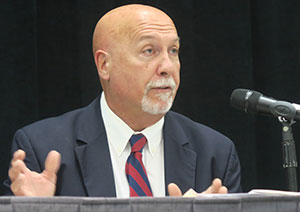Senior Reporter
Experts Discuss Possible Future Risks for Truckers

[Stay on top of transportation news: Get TTNews in your inbox.]
SAN DIEGO — A panel of experts discussed the safety challenges and opportunities that exist for truckers out on the road today, including how emerging technologies both promise improvements but also raise questions.
“When we look at the crash figures, we have to look at all of the crashes, and that includes car crashes,” said Sean Garney, co-director of Scopelitis Transportation Consulting, during an Oct. 24 panel exploring some of the trucking industry’s emerging safety risks during American Trucking Associations’ 2022 Management Conference & Exhibition.
“As an industry, I think we’re actually doing pretty good,” Garney said. “Our future risk is learning how to interact with all of those other people around us.”
Over the past year, data shows driver attention behind the wheel has improved significantly, but speeding violations have been on the rise, said Gary Johnson, director of safety services for Lytx. According to Johnson, in 2022 versus 2021, drowsy driving has decreased by 18% but posted speed violations have increased 19%.
The arrival of billions of dollars in federal infrastructure funding will also bring with it over the next three to five years an increase in construction zones, which will bring a new safety challenge to truckers, said Dan Murray, senior vice president of the American Transportation Research Institute. Currently trucks are involved in more than one in four work zone fatalities, he said. “There will be a huge uptick in work zone accidents,” Murray said.

Fields says even with technology, "the driver is still going to be king." (Anneliese Mahoney/Transport Topics)
Looking further out, automated technology is poised to bring improvement, but some experts have questions about the still-emerging technology. Murray said he believes the industry is on the cusp of advances in Level 2 and 3 autonomous trucks that will be credited with crash reductions. But Joshua Vance, vice president of safety and compliance for J.B. Hunt Transportation, said truckers are facing more near-term challenges.
“I hope you’re right,” Vance told Murray, “but I’m just not sure that thinking about five to 10 years is enough time. It feels like we’re further away from that, and so we have to focus on the things that we’re focusing on today and train our drivers using defensive driving techniques.”
Murray agreed that driver skill remains important, and that will continue even as autonomous technology develops.
“I totally agree with that,” Murry said. “When you get to Level 4, even potentially 5, the driver is still going to be king. They still by definition will have to take over when technology fails, and technology will fail. It’s not if, it’s when.”
“That’s what concerns me,” added Steve Fields, America’s Road Team Captain and professional driver for Yellow with more than 3 million accident-free miles. “I’ve driven a lot of trucks over the years and there’s always trucks where the cruise control doesn’t work, or lane departure doesn’t work. Equipment fails, and I don’t want to be [in] that truck if it does fail.”
Fields added, “It’s nice, new and shiny on the floor. But when it’s 2 years old and it’s snowing like crazy in Wyoming, things happen out on the road. I’m excited about the technology, but I’m very concerned.”
Want more news? Listen to today's daily briefing below or go here for more info:


